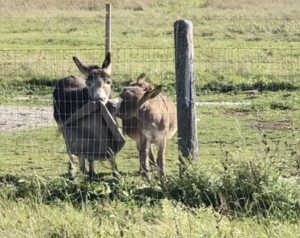Lately, I’ve noticed lots of evidence of our donkeys playing hard. Their toys, such as the rubber Wellington boots, the cotton tug ropes, Jolly balls and plastic downspout connectors are in new locations and have new signs of chewing and bashing every time I go out to see them. There’s evidence of much running and playful wrestling – many hoof prints in the sand and turf. Sometimes I’m lucky enough to see the donkey games in progress.
 Playfulness is the best indicator of the donkeys’ happiness and health. When they’re depressed for any reason, such as being stuck inside due to bad weather, they just mope around and the toys never move. When that happens, I give them extra attention, doing ground work with them in the barn, hiding extra treats.
Playfulness is the best indicator of the donkeys’ happiness and health. When they’re depressed for any reason, such as being stuck inside due to bad weather, they just mope around and the toys never move. When that happens, I give them extra attention, doing ground work with them in the barn, hiding extra treats.
The value of joy
It’s not news that joy is important for software delivery teams. Edward DeBono’s research shows that humor is essential for lateral thinking and innovation. And let’s face it, not enjoying our work is sad. Not everyone enjoys the privilege of freedom to change jobs when they aren’t feeling that joy.
I’m currently part of a team that wants to do some experiments to learn whether ensemble programming is more effective if we all work together in one work stream, or we divide the team up and have smaller ensembles working on two work streams.To measure effectiveness, we chose two metrics: cycle time, and “developer joy”. We put together a 5-question survey, largely based on Amy Edmunson’s psychological safety survey. A Slack notification reminds everyone to fill the survey out n Friday afternoon.
i encourage you to find ways to measure your own team’s joy, along with other metrics that are correlated with high-performing teams. I’m a fan of the metrics drawn from the State of DevOps surveys that are detailed in the book Accelerate, including cycle time.
Bringing joy to your team
How can a team ramp up their joy? Based on my own experience, Daniel Pink’s book, Drive, has it right. People who feel they have autonomy to do their best work, mastery of the skills they need to do that, and who feel a strong purpose in how they can add value, enjoy their work more. Feeling appreciated and valued is fundamental to joy in our jobs.
Jenny Bramble has excellent ideas on building better teams through play. Portia Tung, a leading agile coach, has a “school of play” to promote enjoyment at work. However, it takes more than play for us to feel happy in our work. The Modern Agile principles emphasize psychological safety as a prerequisite. Acclerate explains some ways to nurture a culture of high performance. Effective retrospectives, using techniques such as those promoted by Esther Derby, are key for any team’s incremental improvement. Equity, diversity and inclusion are a necessary foundation – and hard work to achieve.
Look around you for signs of team joy, or lack of it. Joy is an agile value we can’t do without.
And if you want to see some happy donkeys, check out some of my donkey videos on my YouTube channel. 😄



One comment on “Looking for joy”
[…] Looking for joy Written by: Lisa Crispin […]